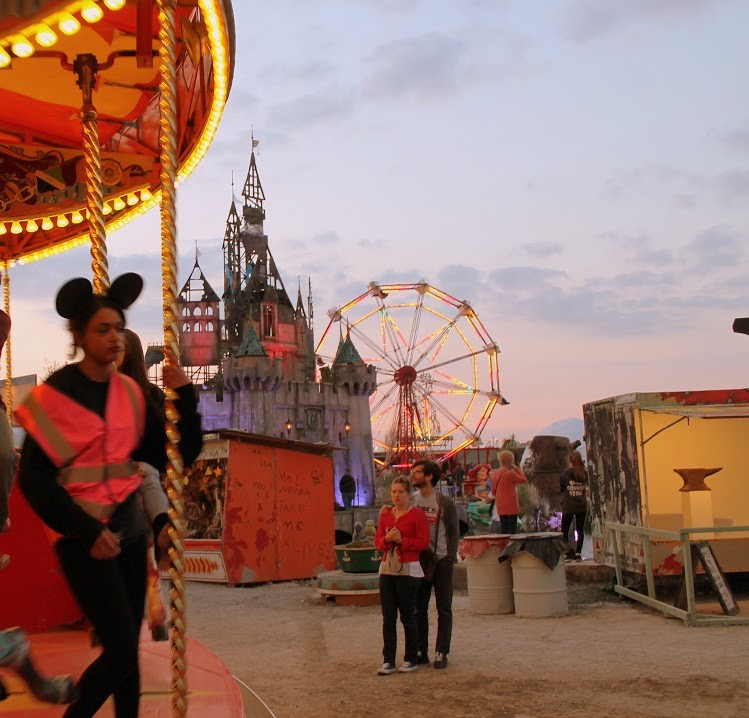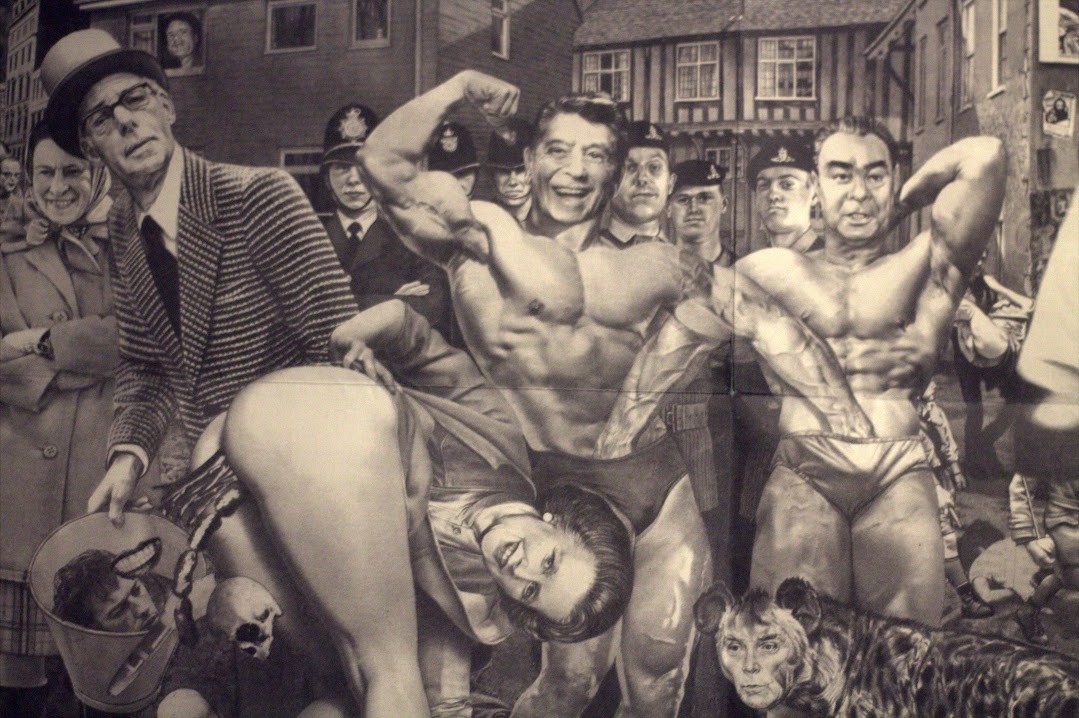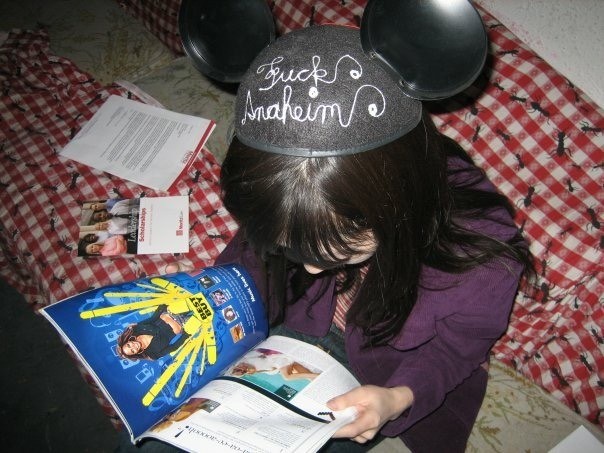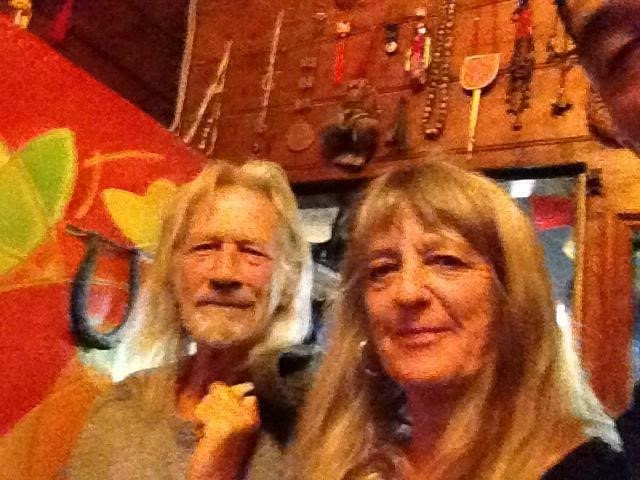
By: Richard Johnson
[Editor's Note: This is the second in a two part series about Richard Johnson's visit to Banksy's Dismaland exhibit in England. Read the first part here.]
After a day spent wandering around Dismaland, the inspiration for the exhibit's message and style became unmistakably clear to an aging punk like myself. When Banksy first emerged in early '90s, he essentially picked up where seminal English punk band Crass left off in 1984. The influence of artist/visionary Gee Vaucher on the visual art of Banksy and other artists at Dismaland is not hard to see. In fact, once you see it, you can't unsee it.
So many of the pieces in the exhibit are similar to the art created by Vaucher–themes that include political satire on war, world leaders, wealth and poverty, animal rights and other topics, the realist style… and don't get me started on the use of stencils. With all of the references to anarchy inside the gates of Dismaland, it's only natural that Banksy is influenced by the band that popularized the big “A” that's stitched, glued and stenciled to every punk's jacket.
See also: The Weekly Finally Visits Dismaland, Part 1
]
“I think there's space for art to be loud, crass and obvious,” Banksy states in an interview on the Dismaland website. Interesting choice of words. Is Dismaland a secret homage to those who paved the way for his success?

In the '80s, Crass used street art, film, music, poetry and pranks to promote their serious message wrapped in subversive humor with one mantra: The government and the system are no good for you and me. Likewise, Banksy uses the same mediums to promote a similar commentary on inequality and impending catastrophe. In the case of Dismaland, the message is just presented in a more consumer and family-friendly way than before.
What this exhibit comes down to is a bit like Crass–a good-spirited and educational joke, even if some of the commentary comes off as grotesque at times. Dismaland has brought much needed tourism revenue to the town it inhabits and, unlike Disneyland, is not so overpriced that a regular family can't afford entry. If I sound as though I am gushing over Dismaland, it's perhaps because I feel an odd sort of kinship with the park itself.

At AAA Electra 99 Art Gallery and Museum, the little artist co-op gallery and music venue that I ran in the shadows of the Magic Kingdom for almost two decades, we, like Banksy, borrowed heavily from the Crass ideology. We would mock and taunt our Goliath neighbor relentlessly, going as far as to reprint their money (Disney Dollars) on flyers that we handed out at an Anaheim City Council meeting with Disney Representatives in attendance. And, just as with Dismaland, they never even acknowledged our existence. Although Banksy has made it clear that he is not worried about any Disney backlash due to the new British laws on parody, when all's said and done, after the expense of running Dismaland while only charging 3 pounds to get in and with such a limited number of patrons allowed in per day, Banksy may not have much money left for Disney to take even if they tried.
I wanted to know what the former members of Crass thought of Banksy and Dismaland, which sounds silly, but the truth is that I try to make it a point to visit Dial House whenever I'm in England, and this was as good of an excuse as any to visit.
For decades, Crass' visual artist Gee Vaucher and co-founder Penny Rimbaud have inhabited Dial House, a farm cottage in the countryside of Essex that's become a mecca to hippie punk types. Crass was formed there in 1977.
[

I tend to be in the area whenever the residents of Dial House are busy, sick or on their way out the door. I'm known as the King of Impeccable Timing. Regardless, they are always good enough to humor me when I show up. Penny and Gee are wonderfully honest and friendly people who care about others and have stayed true to their hippie beliefs. Gee is not as willing to reminisce on the past as Penny, but I believe that she knows the profound effect her early work has had on the art world – a world I am not sure she even wants to be part of.
On my post-Dismaland visit, Gee wasn't feeling well, but I was able to have a long conversation with Penny. Penny is a philosopher, jazz musician, writer, artist and, he boasts, an excellent bread maker. He is always a joy to talk to and doesn't mind discussing Crass. Aside from gabbing about the band's history of artful anarchy, we detoured into conversations about ejaculation, Chinese healing therapy, vaping and the Sleaford Mods. The Sleaford Mods are a minimalist, hip-hop punk duo of 40-somethings from Nottingham who are enjoying surprising popularity and played a show at Dismaland on September 18. They are clearly influenced by Crass and happen to be one of my favorite current bands, so I was very interested in Penny's opinion of them, and of course his thoughts on Banksy and Dismaland.

Not a negative word came from Penny's mouth about anything. He thought the Sleaford Mods' message could be a bit more positive, but then clarified his position by adding, “I'm 72, what do I know of today's music?”
Penny did say he was very touched by a note that he received from the singer of the Sleaford Mods, Jason Williamson, shortly after suffering a heart attack last year.
When I brought up Banksy and how I feel that the elusive artist should be over at Dial House helping to clear the drains and trim the trees as he owes everything to Gee and Crass… Penny just smiled.
“I know Gee and Banksy have collaborated in the past,” he said. “I am not sure if she has work at Dismaland. If you want to know about their relationship you'll have to ask her.”
So off to the main house I went to ask her.
Gee is a blunt, quick-witted artistic genius, always ready to put me in my place. I guess you could say we have a love/hate relationship. I love her and she hates that deep down she loves me, even though I am a wacky American, very loud, and I love to talk about Crass which she does not. I'm aware that I drive her a “little bonkers” sometimes. She wasn't feeling well, so I softened my approach.
“What the fuck is up with you and Banksy? That motherfucker should be writing you a check or at least be here doing yard work!”
She looked at me with just a bit of a smile and a look that pierced right through me and said, “Richard. You know I don't want anyone's check,” and then gave me a very out of character hug.
“I'm not feeling well. I am going to lie down. Perhaps we can discuss this another time. It's lovely to see you Richard – when are you leaving?”
I didn't expect to get any more out of her, even though I secretly hoped to. I guess neither Gee nor Banksy really care what anyone thinks or about posterity. In the end that might be one of their most profound similarities. As a fan and fellow artist I just wanted her to know that I believed she had influenced something that I thought was positive, thought-provoking and funny. Judging by her and Penny's reaction to what I thought was a total epiphany, she already knows the effect her art has had on Banksy, on Dismaland, and on the world. In true Gee Vaucher fashion, I don't think she cares.
See also
10 Punk Albums to Listen to Before You Die
10 Goriest Album Covers
10 Most Satanic Metal Bands
Follow us on Twitter @ocweeklymusic. Like us on Facebook at Heard Mentality.

